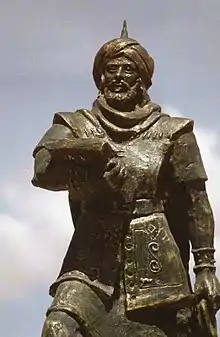Uqba ibn Nafi
Uqba ibn Nafi ibn Abd al-Qais al-Fihri al-Qurasyi (Arabic: عقبة بن نافع بن عبد القيس الفهري القرشي, romanized: ʿUqba ibn Nāfiʿ ibn ʿAbd al-Qais al-Fihrī al-Qurasyī) was an Arab general serving the Rashidun Caliphate since the Reign of Umar and later on the Umayyad Caliphate during the reigns of Muawiyah I and Yazid I, leading the Muslim conquest of the Maghreb, including present-day Algeria, Tunisia, Libya and Morocco.
ʿUqba ibn Nāfiʿ عقبة بن نافع | |
|---|---|
 A statue of Uqba ibn Nafi in Algeria | |
| Governor of Ifriqiya | |
| In office 666–674 | |
| Monarch | Muawiyah I |
| Preceded by | Mu'awiya ibn Hudayj |
| Succeeded by | Abu al-Muhajir Dinar |
| In office 681–683 | |
| Monarch | Yazid I |
| Succeeded by | Abu al-Muhajir Dinar |
| Succeeded by | Zuhayr ibn Qays |
| Personal details | |
| Born | 622 Mecca (present-day Saudi Arabia) |
| Died | 683 Tehouda[1] (near the oasis of Sidi Okba in present-day Algeria) |
| Resting place | Sidi Okba Mosque, Algeria |
| Relations |
|
| Children | Abi Ubaida ibn Uqba |
| Parents | Nafi ibn Abd al-Qais Salma bint Harmalah |
| Military service | |
| Allegiance | Rashidun Caliphate Umayyad Caliphate |
| Branch/service | Rashidun army |
| Years of service | 635–683 |
| Rank | General |
| Battles/wars |
|
ʻUqbah was the nephew of Amr ibn al-As. He is often surnamed al-Fihri in reference to the Banu Fihri, a clan connected to the Quraysh. His descendants would be known as the ʿUqbids or Fihrids. ʻUqbah is the founder of the cultural city of Kairouan in Tunisia.
ʻUqbah accompanied Amr in his initial capture of cities in North Africa starting with Barca, then proceeding to Tripolitania in 644. In 670 now the emir or commander, ʻUqbah led an Arab army to North Africa, crossing the Egyptian deserts, and setting up military posts at regular intervals along his route. In a region of what is now Tunisia, he established the town now called Kairouan (meaning "camp" or "caravanserai" in Persian) about 99 miles south of present-day Tunis, which he used as a base for further operations.
According to one legend, one of ʻUqbah's soldiers stumbled across a golden goblet buried in the sands. It was recognized as one that had disappeared from Mecca some years before, and when it was dug out of the sand a spring appeared, with waters said to come from the same source as those of the sacred Zamzam Well in Mecca.[2] This story led to Kairouan becoming a place of pilgrimage and then a holy city ("the Mecca of the Maghreb") and the most important city in North Africa.
In 683 ʻUqbah was ambushed and killed by the Berber Christian king Kusaila in the Battle of Vescera. He died beside his hated rival, Abu al-Muhajir Dinar. His armies evacuated Kairouan and withdrew to Barca, though it was recaptured in 688.[3] Al-Watiya Air Base in Libya is also known as "Okba ibn Nafa Air Base" after him.
Historical accounts
Most of the accounts describing Arab conquests of North Africa in general and Uqba's conquests in particular date back to at least two centuries after the conquests have happened.[4]
One of the earliest reports come from the Andalucian chronicler Ibn Idhari in his Al-Bayan al-Mughrib. In it, Ibn Idhari describes the moment when Uqba reached the Atlantic Ocean, where he allegedly said, "O God, if the sea had not prevented me, I would have galloped on for ever like Alexander the Great, upholding your faith and fighting the unbelievers!"[5]
Edward Gibbon, referring to Uqba ibn Nafi as Akbah, gives him the title "conqueror of Africa," beginning his story when he "marched from Damascus at the head of ten thousand of the bravest Arabs; and the genuine force of the Moslems was enlarged by the doubtful aid and conversion of many thousand Barbarians." He then marched into North Africa. Gibbon continues: "It would be difficult, nor is it necessary, to trace the accurate line of the progress of Akbah." On the North African coast, "the well-known titles of Bugia, and Tangier define the more certain limits of the Saracen victories." Gibbon then tells the story of Akbah's conquest of the Roman province of Mauretania Tingitana:
The fearless Akbah plunged into the heart of the country, traversed the wilderness in which his successors erected the splendid capitals of Fez and Morocco, and at length penetrated to the verge of the Atlantic and the great desert.... The career, though not the zeal, of Akbah was checked by the prospect of a boundless ocean. He spurred his horse into the waves, and raising his eyes to heaven, exclaimed: 'Great God! if my course were not stopped by this sea, I would still go on, to the unknown kingdoms of the West, preaching the unity of the holy name, and putting to the sword the rebellious nations who worship another gods than Allah.'
Although much scholarship on the life and conquests of ibn Nafi are available, most have not been translated from their original Arabic into English or French.
References and notes
- "Discover Islamic Art - monument_isl_dz_mon01_15_en". Virtual Museum.
- Places of peace and power - Kairouan, Tunisia - Sacredsites.com
- Conant, Jonathan (2012). Staying Roman : conquest and identity in Africa and the Mediterranean, 439–700. Cambridge New York: Cambridge University Press. pp. 280–281. ISBN 0521196973.
- Corradini, Richard; Helmut Reimitz; Marx Diesenberger (2003). The Construction of Communities in the Early Middle Ages: Texts, Resources and Artefacts. Brill Academic Publishers. p. 303. ISBN 90-04-10845-9.
- Ibn Idhari, Al-Bayan al-Mughrib fi akhbar al-Andalus, 1 ed. G. S. Colin and E. Lévi-Provençal, 2 vols. (Leiden 1949) p. 27
External links
- Edward Gibbon, History of the Decline and Fall of the Roman Empire Chapter 51
